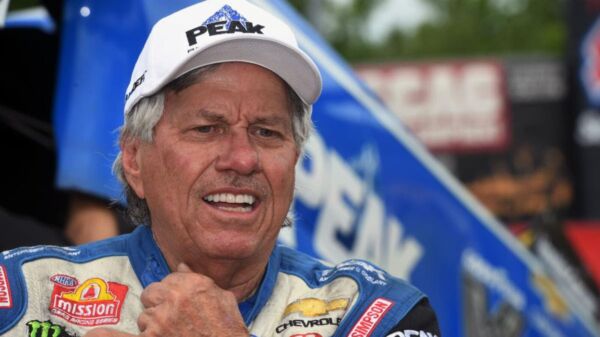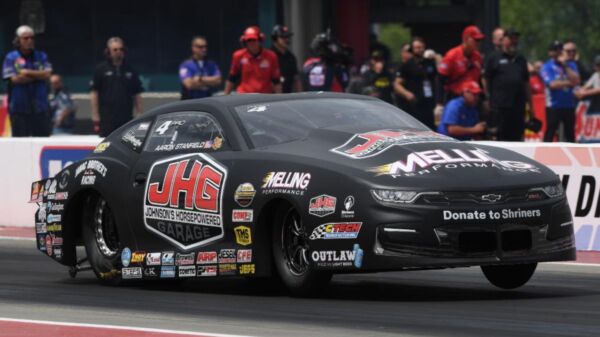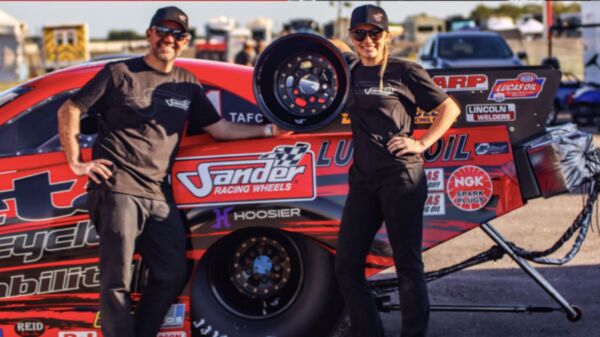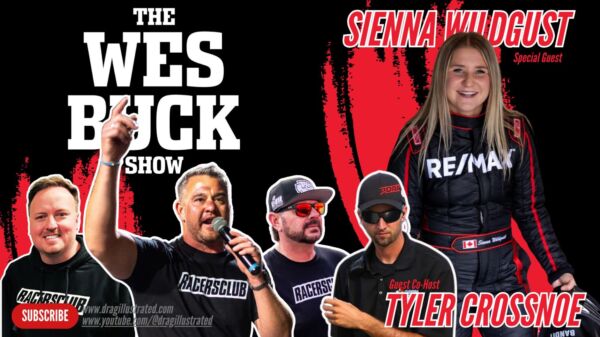I mean where…the hell…should I…really even start?
Sorry, been dying to drop those Drake lyrics here on the podcast and finally felt compelled with all that’s gone on this week.
What am I talking about? Of course, the big – albeit not totally unexpected – news out of the NHRA that they would be introducing two new engine combinations to the E3 Spark Plugs Pro Mod Drag Racing Series for 2020. It seemed as if the chutes on “Stevie Fast” Jackson’s Bahrain 1 Pro Mod Camaro had hardly blossomed before NHRA’s technical department dropped this bombshell – that 526 cubic-inch centrifugal supercharged engines and 960ci nitrous injected engines would be allowed next season.
Bombshell is actually a bit of a stretch as this isn’t exactly a shocking development for anyone who’s been paying attention as rumors regarding this move started as early as the beginning of last season – perhaps even earlier – and only intensified here in the second half of 2019. I’d say it was at the U.S. Nationals when three ProCharger-equipped Pro Mods – two well-established cars in that of Kevin Rivenbark and John Strickland’s GALOT Motorsports first-generation Camaros and a brand-new Elite Motorsports-fielded late-model Camaro – that it seemed that the writing was officially on the wall and we’d see these cars “join the club” in the very near future.
LISTEN TO THE AUDIO VERSION OF THIS OPINIONATED-EDITORIAL HERE…

Expected or not, it’s hard not to see this as a legitimate “big deal” in drag racing, specifically Pro Modified. First off, this is a class that was birthed by the heads-up desires of Top Sportsman racers in the late ‘80s (as well as the business acumen and innovative spirit of Mike Thermos, founder of Nitrous Oxide Systems – NOS). Back then it was big inch (for the time) nitrous engines and supercharged wedge-headed engines, then came even bigger nitrous engines and then blown alcohol Hemis – which, as a side note, I believe is kind of an unsung ripple in the history of Pro Mod and probably not talked about enough.
The biggest curveball the class had seen, in my opinion, was with the introduction of the twin-turbocharged combo, which first started – same with blowers – on wedge-headed engines and then eventually Hemi-headed pieces. Initially, turbo cars in NHRA-legal competition were far less regulated than they are now, largely treated like supercharged cars – there was no boost limit, no turbo size limit, up to 650 cubic inches, etc.
I remember those early days and, honestly, felt horrible for the handful of guys that were giving it hell with those hairdryers. Mike Moran started showing up to NHRA national events here in there as far as back as like 2005, I think, and it wasn’t until 2008 that he actually qualified for an event that had more than 16 cars (Las Vegas, No. 10 with a 6.11 at 245). That car had a 650-inch big block with twin 91mm Precision turbos on it. Today, turbo racers are limited to 526ci and twin 88mm turbochargers, and limited to 33psi – probably only 60% of what those units are capable of producing.

During that time you also had Brad Personett making waves in Ed Marx’s ’53 Corvette with a twin-turbo Hemi and a Lenco with a 10.7” RAM clutch.
By 2009, Personett was really getting things stirred up with low 5.90 runs at 250-plus and I think that’s when everyone started to get concerned with the potential of this combination. I think it was late that very year, during SEMA, that I got a call from a top-ranked individual in the Pro Mod deal asking me something along the lines of, “What do you think about the twin-turbo deal in Pro Mod?”
Basically, there’d started to be some pushback from the blower and nitrous racers – serious pushback – and a fairly common belief that wherever this combination goes it dominates and/or “ruins things.” The example I was provided by yet another well-known, championship-winning racer was that of NMCA Pro Street and Bob Rieger and his twin-turbo small block-powered Chevy S10 and then his BBC-powered ’57 Chevy – another somewhat unsung hero of the turbo revolution.
“They put weight on him, and he’d just go faster,” this gentleman told me. “There’s nothing you can do to slow them down – the combination is evolving faster than the rules could ever keep up. Everywhere those cars [turbocharged cars] go they ruin everything. They’re so far away from their performance potential that it’s not realistic to have us compete on a level playing field. Nitrous cars? Blower cars? They’re close to their limits – period.”

To answer the question I’d been asked, I had to admit that I felt the cat was already out of the bag and there likely wasn’t any going back. My belief was that the turbo cars needed further regulation – namely the same kind of mechanical limitations that the nitrous and supercharged entries contend with in the form of cubic inch limits and supercharger overdrive, respectively.
Believe me when I tell you that there were several people that were in favor of just writing the turbo cars out of the rules entirely. Several.
In 2011, NHRA took a step in the right direction with a spec 88mm rule, but that alone wasn’t enough to effectively slow down the turbo cars. For example, at the last race of the season that year the top three cars in qualifying were twin-turbocharged – Personett No. 1 with a 5.84 at 256.70, Leah Pritchett with an .85 at 252 and Melanie Troxel (bit of a blast from the past) with a 5.89 at 253. There was literally a 12mph disparity between the top turbo speed and the top supercharged speed and almost 20 (18, actually) to the fastest nitrous car – one funded by a foreign country.

It feels like it’s important to note here that this was an especially interesting time for Pro Mod – the class was finally getting the recognition it deserved from NHRA, largely thanks to Roger Burgess’ investment in the class sponsorship-wise by way of his giant pharmaceutical company ProCare RX and Get Screened America program. Prior to this period, NHRA Pro Mod was, for lack of a better phrase, on life support. Participation had dwindled, interest in other sanctions and series was on the rise, and all the sponsorship saviors that had been involved in the class over the years had dried up or turned their attention elsewhere. So, the idea of legislating any combination out of the series was a non-starter.
NHRA went a step further in reigning the turbo cars in come 2013 when they mandated Joe Oplawski’s Hyperaktive boost controller as the spec unit for the class’ turbocharged entries, which NHRA used to mandate a maximum of 43 pounds of boost.
There was at least one other significant development during this 2010-2013 timeframe, and that was the banning of automatic shifters after the season-opening NHRA Pro Mod Drag Racing Series event in 2010, and then re-introduction of the devices shortly thereafter. There’s a lot to be said about this particular subject, but we’ll save that for another time.
Fast forward through the next six years and you’ll get us to NHRA Pro Mod as we currently know it – 14-71 roots-style supercharged Hemi-headed 526ci engines in suspended doorslammers at 2,600-pounds, twin-turbocharged Hemi-headed 526ci engines at 2,650-pounds and nitrous oxide-injected engines up to 910ci competing at 2,500-pounds. The 2,500-pound weight minimum, to my knowledge, is far and away the heaviest nitrous Pro Mods have ever been.
Heading into 2020, however, those three established combinations will be joined by 960ci nitrous engines, presumably with lock-up converters at a heavier weight, and ProCharger-equipped 526ci Hemis at a yet-to-be-determined weight – albeit I’ve heard through the grapevine that 2,600-2,650-pounds will be where they settle.

Three very different yet arguably very competitive combinations has, again, in my opinion, served to make the E3 Spark Plugs NHRA Pro Mod Drag Racing Series among the most exciting, competitive and controversial eliminators in all of drag racing. While much has been said about the inclusion of yet two more combinations, I’m here to say that I don’t know that this is going to be the seismic happening some (many?) expect.
SO, THE BIG QUESTION…HOW WILL THIS DEVELOPMENT IMPACT PARTICIPATION IN THE NHRA PRO MOD DRAG RACING SERIES?
Personally, I don’t believe the inclusion of these two new engine combinations alone will result in a landslide of fresh faces and new competitors. The door certainly opens a little wider, but it was the news that broke on DRAGILLUSTRATED.com back over Labor Day’s NHRA U.S. Nationals that the Real Pro Mod [RPM] group would soon disband and NHRA would open their arms to Pro Mod racers, essentially, one-and-all for 2020 that served as the battering ram – not this rule amendment.
If there’s a ton of new racers and teams that turn up in Gainesville next spring, it’ll be almost because the financial barrier to entry that has existed for every bit of the last five years – coupled with the sportsman grade point system – that served as the catalyst. That’s right, friends. If you want to run NHRA Pro Mod in 2020, no longer will you need to first earn enough grade points to try and squeak into one of the fields where the quota wasn’t met or following the rumor of a late withdrawal; nor will you need to purchase a provisional by way of a race sponsorship to the tune of multiple tens-of-thousands of dollars. You want in? Buy a tech card for $800 or whatever it is (but I think that’s right) and join the party. There’s yet another story to be told in regard to this situation and the NHRA’s recently explained sliding-scale-car-count-based entry fee program for Pro Mods, but we’ll save that, too, for later.
I suppose there’s a possibility the powers that be in Glendora have made calls and confirmed participation by more people than me, but I’ve rang enough phones in the last two weeks to identify a best-case scenario of three ProCharger cars joining the series on a full-time basis next season, but more than likely two. On the big-inch nitrous side, unfortunately, I haven’t been able to confirm a single full-pull, 12-race fresh-faced entrant. To be honest, it kind of reminds me of the lock-up torque converter deal a couple years ago. All the talk indicated there’d be “a ton” of new nitrous cars turning up if NHRA were to let in the lock-up, and I think after Jonathan Gray and Shannon Jenkins left, and Chad Green came in we still ended up down on nitrous cars.
Obviously, the idea behind allowing in the 960-inch cars is to attract outlaw racers on the East Coast, specifically PDRA Pro Nitrous division competitors, which is something that I’ve been a proponent of for a while. For me, it’s pretty hard to argue against a strategy that seeks to go where the numbers are, and I’m glad they did it even though I’ve yet to identify a single PDRA Pro Nitrous-level racer that has told me they’re planning on going quarter-mile racing in 2020 on a full-time basis.
Why? Because I think it was the only option. I’ve been racking my brain for the better part of the last two years as to how we at DI can somehow popularize and promote nitrous in Pro Mod. Spurred by a casual conversation with Modern Racing’s Justin Elkes, who in 2019 led the charge for Elite Motorsports as they delved into Pro Mod racing, I was encouraged to “make it fashionable to race a nitrous car.” I loved Elkes’ outlook on what remains a bleak situation. His belief was that if it could be argued or even become popular belief that a nitrous car could be competitive or even have an advantage in NHRA Pro Mod that all it’d take is a concentrated effort to make it a cool, forward-thinking thing to do to possibly push a few racers over the edge – to give it a shot or even make the switch. We both agreed that it was a longshot and the very definition of optimistic thinking, it seemed worth a try. Thus, we made an effort here with the magazine – as well as across our digital and social channels – to shine a lot on successful nitrous racers every chance we could, especially since we had no influence over the rules.
NHRA handled that part – conveniently (sarcasm implied) – two weeks before our third-annual DRAG ILLUSTRATEDWorld Series of Pro Mod this summer, lowering the boom on turbo cars with a 3psi drop and a much, much less impactful two-percent reduction in overdrive for blown alcohol racers. Heading into the fall, it was basically an accepted fact that the rules favored nitrous cars. Since then the NHRA has increased the minimum weight for nitrous cars by 75-pounds (2,425 to 2,500) in an effort to even things back out. And before your head starts to explode thinking about a freaking 75-pound weight penalty for any combination in any class, please know that it was much closer to 35 (or less) for most as I’m not aware of any car that was able to routinely make the 2,425 mark (perhaps Chad Green’s Jerry Bickel-built Camaro, which I know he spent a lot of money on to get super light).
Long story long, I believe it’s going to be a real challenge for the NHRA Pro Mod Drag Racing Series to obtain – let alone maintain – a car count meeting or exceeding 35 cars. While I’d love to see it happen, I can’t help but feel like the series has reached a level of performance and competitiveness where achieve that kind of participation will be extremely difficult. A significant bump in the purse money – increasing first-round loser money to $1,000 or better from the current $300 – would be a big help.
SO, WHY WON’T WE SEE A MASSIVE INFLUX OF NITROUS CARS?
Of course, this is simply my personal opinion – and I’m cool with being wrong and, frankly, hopeful that I am in this case – but I just don’t see a fleet of current PDRA Pro Nitrous racers fleeing that arena for that of the NHRA national event scene, nor do I expect too many NMCA Xtreme Pro Mod, Northeast Outlaw Pro Mod or any other of the various sanctions/series that allow 960-inch nitrous cars to turn up in the E3 Spark Plugs-backed NHRA series too terribly frequently.
My sincere hope and belief is that we’ll see a few of those nitrous racers turn up when it’s convenient – at a handful of races that are a reasonable tow. It’d be absolutely awesome to see a PDRA star like Lizzy Musi, Jay Cox or recently crowned Pro Nitrous champ Jim Halsey show up and show out (as Keith Haney would say about himself) in Gainesville or Charlotte where a bunch of those bottle-fed cats are based. Maybe Tommy Franklin tries his hand at the quarter-mile when Pro Mod returns to the NHRA national event at his very own Virginia Motorsports Park? It’s hard to tell. Most any Pro Mod racer worth his salt and with a legal race car would struggle to resist the allure of competing at the NHRA U.S. Nationals in Indianapolis, which is one of the few events I can easily imagine reaching the 35-car mark.
The problem is it’s not as simple as showing up, and I’m not sure that’s been considered by everyone that should have been considering it.
For instance, there’s a minimum of $2,000 to be spent on electronic automatic shut-off safety parts for any non NHRA professional class race car. Perhaps you’ll have to add a case to your transmission and therefore build a transmission tunnel? That’s an easy 5- to 8,000-dollar investment. Then you’ll need to have the underside of your car’s carbon fiber front end coated with flame retardant paint (roughly $2,000). That’s every bit of $12,000 you’ve spent to go NHRA Pro Mod Drag Racing before you’ve left the house. Most eighth-mile nitrous cars are going to have a 4.86 or 5.0 rear gear, too, so you’ll also need to pick up a pair of center sections, and probably some gearsets for your transmissions. Holy crap, right? You’re talking over $20,000 to be really ready to go quarter-mile racing if you’re a routine eighth-miler.
There’s also the legit financial wherewithal required to embark on a single national event and/or the entire 12-race series and how that addition to your schedule will hinder most these racers likely focus, are earning points and competing for a championship – PDRA Pro Nitrous, NMCA Xtreme Pro Mod, etc. Say the typical PDRA Pro Nitrous car consumes 6,000-6,500 lbs/hr of nitrous during the course of a 3.6-second run, a nitrous car that has to live to race another round of quarter-mile drag racing (multiple 5.7-6.0 second runs) can only consume 5,000-5,500 lbs/hr. The margin for error and ability to survive aggressive tuning is monumentally changed when another 660-feet come into play. Does a frontrunning PDRA Pro Nitrous player who enjoys two-day races and the ability to travel home on Sundays to be in the office on Monday really want to lose a handle on his baseline tune-up?
Honestly, I’m not sure. Will there be some that give it a go? Abso-freaking-lutely. And to those racers, we say “thank you,” but I’ve scoured the sheets and I don’t see many names that jump out to me as nitrous racers that are going to come running. Maybe I’m wrong and, again, I genuinely hope that I am, but this E3 Spark Plugs NHRA Pro Mod Drag Racing Series deal is different. Say what you want about radial racing or Pro Stock or whatever else, but eight of the top nine points earners this year in NHRA Pro Mod were all financially backed on some level by a foreign country. That’s not an international business, my friends – that’s an entire nation. The cars are emblazoned with flags and the initials of foreign royalty. It’s a wild time
IS ANYONE ELSE CURIOUS ABOUT THE MECHANICS OF ALL THIS?
While I know that a tremendous effort and investment have been made by ProCharger, as well as several prominent engine builders, namely Eric Dillard’s Pro Line Racing Engines and Richard Freeman’s Elite Performance, to turn the centrifugal supercharged Hemi into a reliable and competitive option for quarter-mile Pro Mod racers, I believe everyone involved would admit this is a combination that is still in development with a lot of room for improvement and considerable unknown.
The same can be said for 960” nitrous engines on the quarter-mile. There’s very little data to pull from with this combination and consistent 1320-feet pulls. Typically, when we see these cars run quarter-mile it’s at special beginning-of-the-year or end-of-the-year outlaw races in mineshaft conditions and on superbly prepped surfaces (i.e. Dean Marinis’ 5.57, Fredy Scriba’s 5.67 and Ed Burnley’s 5.73).
For most these NHRA Pro Mod racers, it’s not unusual to make 100-120 runs a year. I’ve spoken with several racers who believe they might need to put a crankshaft in one of these 960” engines after 30-40 quarter-mile runs to be safe, and when they’re in the neighborhood of $7,500 a whack, well, you better have a strong stomach for engine maintenance-related expenses. Being that these cranks aren’t available via Amazon Prime, you’d probably better go ahead and order two of them to be ready for Gainesville.
Regardless, I only say this to make the point that all of this is – at the least – extremely complicated. To say the NHRA technical department has their collective hands full is an understatement. I don’t envy their position, and I sincerely applaud their effort to try things and take chances. There was no chance that we’d see any new nitrous cars in NHRA Pro Mod for 2020 without a rule change, so the door is now open. How many come through? How long will those that do stay? I’m not certain.
I’ve made enough calls and sent out enough text messages to strongly believe that there are at least 8 ProCharger cars interested in NHRA Pro Mod next year on some level. Considering 36 cars earned championship points this year – the lowest number since 2012, with the highest being 47 in 2018 – the influx of cars produced by these aforementioned inclusions would most certainly serve as return to glory for what is one of the true bright spots in drag racing right now. Those cars, in conjunction with those that are produced by the series’ new open-door policy, could produce the first 50-plus car season in the history of the NHRA Pro Mod experiment, and that’s pretty exciting. An interesting side note is that NHRA Pro Mod averaged 21 cars in 2019, roughly 58% of its total participation for the year. In order to hit the target of 35 cars on average next season you’d need closer to 98% involvement with things as-is. Assuming you’d maintain nearly sixty percent of your racer base competing at all 12 events, it’ll take 60 total cars earning points in 2020 to reach the goal.
In closing, I have to at least acknowledge the X-Factor that is competing for a Wally at a NHRA national event. That situation – simply purchasing a tech card, seeing one’s name on the entry list and merely having a chance to win a Wally in a professional eliminator category – is the Holy Grail for an entire world of drag racers. It might not be everything to everybody, but I have firsthand experience with this, and let me assure you that the pull is strong. And the NHRA knows it. There’s nothing like being in the staging lanes at the Gatornationals or the U.S. Nationals; racing in front of sellout crowds and on cable television; having swarms of fans pass by your pit. I’ve seen racers get giddy, child-like excited about waiting in traffic to get in a race they’re competing in – just knowing all this traffic is there for them. Racers can say what they want, but they all want to race against the best of the best and do it on the biggest stage in drag racing, and that’s the NHRA national event stage.
All I know is that part of the magic of Pro Mod is a multitude of different power adders competing – fairly – against one another, and that it’s every bit as important to preserve the combinations that already exist in this format as it is to introduce new ones.
This story was originally published on November 12, 2019. 























